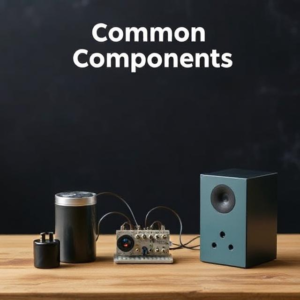Electronic components are the building blocks of electronic circuits. They control and manage the flow of electricity in different ways. Here’s a simple explanation of the most common types of electronic components:

1. Resistor
- What it is: A resistor is a component that resists the flow of electricity. It reduces the current that passes through the circuit.
- How it works:
- It doesn’t allow too much current to flow, which helps protect other components from damage.
- It’s like a bottleneck in a water pipe that controls how much water flows through.
- Example: In a light bulb circuit, resistors can be used to control the amount of current going into the bulb, preventing it from burning out.
2. Capacitor
- What it is: A capacitor is a component that stores electrical energy temporarily and releases it when needed.
- How it works:
- It has two metal plates separated by a non-conductive material, and it stores energy when electricity is applied.
- It acts like a small battery, releasing energy when the circuit needs it.
- Example: In a camera flash, capacitors store energy and then release it quickly to produce a bright flash of light.
3. Inductor
- What it is: An inductor is a coil of wire that creates a magnetic field when current passes through it.
- How it works:
- It resists changes in the current and can store energy in the magnetic field.
- It’s like a “slow-down” device that makes the current take longer to change its flow.
- Example: Inductors are used in power supplies to smooth out the flow of electricity.
4. Diode
- What it is: A diode is a component that allows current to flow in only one direction.
- How it works:
- It acts like a one-way valve for electricity, letting it pass in one direction but blocking it in the other direction.
- It’s useful for controlling the direction of current.
- Example: In a battery charger, diodes make sure that current only flows into the battery and not out of it.
5. Transistor
- What it is: A transistor is a switch or amplifier that controls the flow of electricity in a circuit.
- How it works:
- It can either allow current to flow or stop it, depending on a small electrical signal.
- Transistors are like electronic switches, turning things on and off or amplifying signals.
- Example: In a radio, transistors amplify weak signals so that you can hear them clearly.
6. LED (Light Emitting Diode)
- What it is: An LED is a special type of diode that emits light when current flows through it.
- How it works:
- Just like a regular diode, it only allows current to flow in one direction, but it also produces light when the current passes through it.
- Example: LED lights are used in everything from TV screens to traffic lights because they are energy-efficient and last a long time.
7. Switch
- What it is: A switch is a simple device that opens or closes a circuit.
- How it works:
- When you press or flip a switch, it either connects the circuit (closing it) or disconnects the circuit (opening it).
- Example: A light switch is a common switch that turns the light on or off.
8. Battery
- What it is: A battery is a power source that stores and provides electrical energy.
- How it works:
- A battery converts chemical energy into electrical energy, supplying power to the circuit.
- Example: The battery in your phone or remote controls is what powers the device.
9. Speaker
- What it is: A speaker is a component that converts electrical signals into sound.
- How it works:
- When electricity flows through a coil inside the speaker, it creates a magnetic field that moves a diaphragm back and forth, producing sound waves.
- Example: The speaker in a phone or TV is responsible for producing the sound you hear.
10. Relay
- What it is: A relay is an electrically operated switch that controls larger currents with a smaller current.
- How it works:
- When a small current is passed through the relay, it activates a switch that can control a larger current.
- It’s like a helper that lets you control big electrical devices with a small signal.
- Example: Relays are used in car systems to control the car’s lights or air conditioning with a small electrical signal.
Summary of Common Components:
- Resistor: Controls current flow.
- Capacitor: Stores and releases electrical energy.
- Inductor: Resists changes in current.
- Diode: Allows current in one direction only.
- Transistor: Amplifies or switches current.
- LED: Emits light when current flows.
- Switch: Opens or closes a circuit.
- Battery: Provides electrical power.
- Speaker: Converts electricity into sound.
- Relay: Switches large currents with small currents.
Each of these components plays a unique role in making electronic devices work. Together, they help us build everything from simple circuits to complex electronics like computers and smartphones!
Keywords: Electronic Components, Electronics


